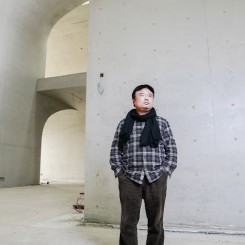Less than a year after the Long Museum was founded in Pudong, Shanghai by the collector-couple Liu Yiqian and Wang Wei in 2012, another Long Museum, this time three times larger, has been erected on the other side of the river. Long Museum West Bund (on the Puxi side) is scheduled to open on March 28, 2014, with “Review: The Opening Exhibition of Long Museum West Bund,” which is curated by Wang Huangsheng, director of the CAFA Museum (Central Academy of Fine Arts Museum in Beijing). Randian interviewed Huang Jian, the managing director of Long Museum, about the Museum’s operations, collections, exhibitions and educational programs.
Randian: How is the Long Museum’s “soft capital”—like the professional expertise of the staff, for instance? Aside from curation, how does Long Museum go about its archival, educational and restoration work?
HJ: I think society these days is not like the past; there really isn’t the problem of closing ourselves off and being oblivious to what’s happening outside. We have learned a lot from the experience of other museums. In terms of hiring, we have a scheme to hire people with experience in the field—hired graduates in fields like museum studies. One thing worth mentioning is that we have not set up a curatorial mechanism, but rather we invite well-known domestic and foreign curators, depending on the nature of the exhibition, to undertake curation. We have set up an academic department which helps these curators turn their exhibition ideas into reality. This helps us avoid having a fixed mindset in the exhibition philosophy—all the while we can be minimalist and professional in terms of human resources.
Randian: What are Long Museum’s plans for public education and to drive foot traffic?
HJ: In the past, the museum’s public education work was the responsibility of the academic department—like seminars and conferences. We had once organized a high-level conference on the “Contemporary Significance of Realist Art”. Aside from that, we have also conducted a forum on private museums in China, inviting representatives from private, official, and foreign museums to discuss the issues facing the growth of private museums in the present. We have, furthermore, programs of public lectures, inviting artists and academics. With the continual growth of academic and educational activities, we later set up a dedicated public education department.
Randian: What is the relationship between the museum and the collections of Mr. and Mrs. Liu Yiqian?
HJ: Mr. and Mrs. Liu Yiqian have been collecting artworks for over twenty years now. They have slowly become one of the most influential collectors in China, and their collections have become more systematic. For instance, Liu Yiqian collects ancient Chinese objects, paintings, and calligraphy, while Wang Wei collects revolutionary and modern oil paintings, and contemporary art. The museum collection is built on the basis of their vast collections. Yet the roles of a collector and a museum director are different; not all the collection will enter the museum. The museum collection is created through intellectual and academic assessment [sic]. Within their collection, only the most valuable part of the collection, which has passed through an academic process of selection, can enter the museum. Of course, after the museum, their collecting has also undergone corresponding changes. This is a mutual, interactive process, since the museum’s collection has also become a question they think about when collecting—so it makes their collection more systematic and intellectually rigorous.
Randian: Who makes up Long Museum’s audiences?
HJ: For this we have some statistics. We have also done some specific promotions within surrounding schools and community. Visitors generally are art lovers, with art professionals making up an especially high number. Aside from that, the Communist and traditional art in our museum collections is very appealing to the general public. The audience segments are very diverse; they can all take what they want from here.
Randian: Does Long Museum have an outreach program for people outside Shanghai and the Yangtze River Delta?
HJ: Not currently, but we are opening the second museum in Shanghai very soon. The current museum in Pudong has over 10,000 sqm of space, which is already the biggest of all private museums in China—but our Puxi branch will be 30,000 sqm. We are confident we will run the two museums well. It was in fact happenstance to open two museums in Shanghai—it wasn’t the intent of Mr. and Mrs. Liu Yiqian. With the Pudong branch, it was fully the work of the couple raising the funds to buy and convert commercial property into a museum. With the Puxi branch, even though they raised the funds, it was the Shanghai Municipal Government that invited them to open the museum, in consideration of the location and cultural environment in Puxi.





